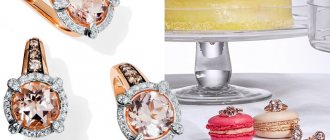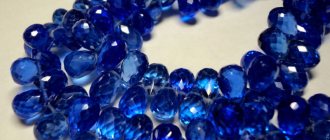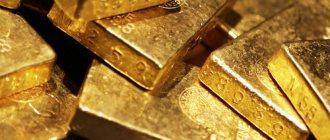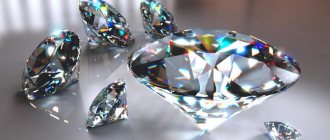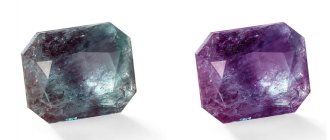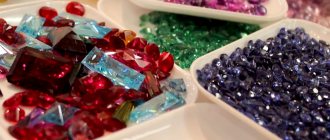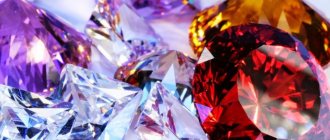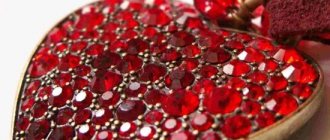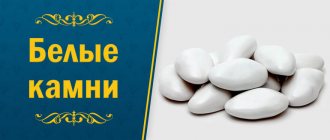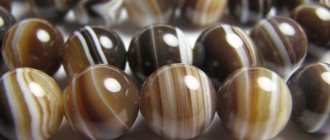Today, the jewelry industry has reached such a level that fashionable and beautiful products are made from almost any material. Conventional precious stones often fade into the background, giving way to more budget-friendly semi-precious and ornamental stones. But not all customers know how the inserts differ from each other and why prices vary so much for minerals that are similar in appearance. To understand this, let’s take a short excursion into the history of the jewelry industry and consider each type of insert separately.
Gems
The most expensive and most valuable inserts. What is the reason for the high cost of such minerals? Let's figure it out in order.
The first thing to consider is that gems are natural minerals formed in a complex way in the earth’s crust. Accordingly, a gemstone can be called such only if it is rare in nature .
Jewelry with cognac diamonds in the “Chocolate” collection
Let us present some statistical data from world practice. The relative cost of mining the most expensive stones as a percentage of the cost of total mining at the beginning of the 21st century was as follows: emeralds - 43, rubies - 14, opals - 10, sapphires - 6, jadeite - 6, turquoise - 5, other colored stones - 16%. This shows that the high cost of precious stones is due, first of all, to the complexity of their extraction.
What other indicators can identify a gemstone among all the others?
Hardness _ The mineral should not be exposed to external influences - scratched or chipped. In Russia, in accordance with the Federal Law “On Precious Metals and Precious Stones,” this list includes natural diamonds, emeralds, rubies, sapphires, alexandrites, and pearls. Unique amber formations are also considered precious stones. From this we see that its high cost is quite understandable.
In addition, the degree of its fashionability . Simply put, the more an accessory falls under the definition of a “fashion trend,” the higher its cost.
The world of precious stones is very large and, unfortunately, confusing, especially when viewed superficially. At the moment, over 2.5 thousand minerals are known, but only a little more than a hundred of them are valuable from the point of view of the jewelry industry and decorative arts.
It is quite difficult to understand the intricacy of varieties of precious, semi-precious and ornamental stones, but there are also valuable natural formations that are not minerals. Therefore, within the framework of this publication, several approaches to the classification of valuable minerals and natural formations will be considered.
Magical and healing properties
Esotericists have calculated the influence of yellow stones on humans:
- give an optimistic outlook on life;
- strengthen the will;
- give self-confidence;
- promote networking;
- serve as a talisman against the evil eye and damage;
- bring peace and harmony to relationships in the home.
Jewelry with yellow stones should be worn all year round. In the summer they are recharged by the Sun, in the fall they lift your spirits, in the winter they warm you up, and in the spring they give you strength.
They treat the gastrointestinal tract, help the heart, and reduce blood pressure.
However, constant wearing (especially jewelry with yellow sapphire) can provoke causeless anxiety.
What types of gems are there?
The names of precious stones and minerals (which, in fact, are the same thing) are presented differently in different classifications, since a unified system has not yet been developed. From a generally accepted point of view, only the most beautiful, rare and expensive minerals and other natural formations can be considered precious stones.
According to Article 1 of the Federal Law of March 26, 1998 No. 41-FZ, officially precious stones are exclusively diamonds, rubies, emeralds, alexandrites and sapphires, as well as pearls of natural origin, that is, organics. Amber is also sometimes included here, but with certain unique features - special inclusions, heavy weight, and so on.
Ring from the “Diamonds of Yakutia” collection in Sunlight
However, there are also nuances here: precious stones in jewelry look very impressive and cost accordingly. But very small or defective minerals lose a lot in value, while semi-precious semi-precious gems of large sizes and rare colors can be equal in value to first-order precious stones.
The science that studies precious stones is called gemology. This is a special section of mineralogy devoted to precious, jewelry, semi-precious and ornamental stones.
Table of precious stones according to the classification of the prominent Soviet and Russian mineralogist E.Ya. Kievlenko seems the most logical and easy to understand. Based on it in the light of modern realities, Doctor of Geological and Mineralogical Sciences E.P. Melnikov proposed an improved version of the classification.
Without going into detail, there are four groups of valuable minerals:
- Gems. Diamond, classic blue sapphire, ruby, alexandrite, emerald and natural sea pearls.
- Jewelry stones. They are divided into four orders. Among the most famous: sapphires of fancy colors, spinel, opals, tanzanite, various types of beryl and corundum (except precious ones), tourmalines, zircons, garnets, freshwater and sea cultured pearls, amethyst, aquamarine, citrine, tiger and cat's eye, apatite, mother of pearl, certain types of quartz and others.
- Jewelry and ornamental stones. Malachite, turquoise, jadeite, lapis lazuli, pink and smoky quartz, jasper, ordinary opals, rock crystal, special grades of jasper, jade, agate, chrysoprase and others.
- Ornamental stones. Jasper, marble onyx, jet, goldite, obsidan, certain types of granite and other ornamental materials of mineral origin.
In addition to pearls, the classifier also includes other materials of organic origin. These are corals, mammoth and ivory. They are considered jewelry and ornamental stones.
The most expensive gems
We will not repeat the above: the most expensive in the ranking of precious stones in terms of value are the last five positions described above. These are gems of the first order and the highest value according to any classification.
But you need to understand that it is impossible to compile an objective list of stones by value: the cost of a carat of a mineral depends not only on its chemical formula, but also on purity, transparency, size, color, presence/absence of defects and other parameters.
Therefore, in this nomination we will present the rarest and most expensive minerals that go beyond generally accepted standards. So, here is a list of truly unique stones, valued at fortunes:
- Tsavorite. Jewelry garnet is yellowish-green in color. A carat costs about 3-5 thousand US dollars.
- Sapphire. An unheated stone of pure blue color is estimated at a minimum of 4.5-6 thousand dollars/carat.
- Red spinel. It is considered one of the fastest growing minerals in price: the cost is 6-8 thousand dollars per carat.
- Demantoid. Another green garnet, but a piercing pure color. Ural demantoid costs about 10 thousand dollars/carat.
- Paraiba. Neon blue tourmaline that glows in the dark. Average quality stones cost 8-12 thousand dollars/carat.
- Emerald. Flawless pure emeralds are extremely rare. The cost of a carat of high-quality unoiled emerald starts from 10-13 thousand dollars
- Padparadscha. The sapphire is an incredible orange-pink color. Cost – 10-12 thousand dollars/carat.
- Alexandrite. The price of this stone ranges from 10-37 thousand dollars/carat. The most expensive are those mined in Russia.
- Ruby. A clean large stone of the top color “pigeon blood” is estimated at 15-25 thousand dollars/carat.
- Jade. The rarest transparent jadeite, known as “imperial”, costs at least 20 thousand dollars per carat.
- Diamond. The cost of a high-quality colorless diamond is about 15 thousand dollars per carat. A blue diamond costs about 30-50 thousand. And the most expensive gemstone in the world is the red diamond: a carat is estimated at 500 thousand - 1 million dollars.
Paraiba Tourmaline
Assortment of minerals
The names of yellow stones appear in all jewelry segments. Their range is created by impurities of lithium, aluminum, sulfur or iron. In amber it is a shade of natural resin.
Precious
Among the stones of the first level there are no simply yellow ones, but there are such varieties.
Diamond
Yellowishness is considered more of a flaw in transparent, colorless diamonds. However, rich color is rare. Out of a hundred thousand pebbles mined in the world, only one is found. This color is the merit of lithium. The more it is, the more intense the shade and the higher the cost of the stone. More about the diamond.
Yellow diamond ring
The number one yellow gemstone is the Sancy Diamond. Named after the first owner Nicolas de Sancy (XVI century). Later it was owned by the Russian princess Aurora Karamzina.
Sapphire
The classic color of this expensive variety of corundum is blue. Yellow sapphire is rare and comes in a range of shades from lemon to amber. The color is often heterogeneous, with iridescence and darkish stripes. It is created by aluminum impurities.
A yellow stone without inclusions from Sri Lanka is especially valued.
Necklace with yellow sapphire
The gem is protected by Jupiter, so you can wear jewelry with it on the eve of your 36th birthday. During this time, the planet revolves around the Sun three times, becoming as useful as possible to humans. Such a sapphire is powerful if given as a gift (including to yourself).
Semi-precious
There are several types of yellow stones of this jewelry value.
Topaz
The entire topaz family owes its name to this variety: “tapas” means yellow.
It was found first, the most common, and regally beautiful.
Transparency, strong brilliance, and full range of tones make it similar to citrine. Yellow is the natural color of the mineral. Others are rare or produced by heating.
Amulet with yellow topaz
The natural variety of topaz is called imperial - a bright, rich yellow-orange or orange-brown transparent stone.
Unlike other gems, the color of topaz does not depend on impurities. It is created by defects in the crystal structure. Yellowness results from the replacement of iron atoms.
Tourmaline
Yellow (along with blue) tourmalines are rare, most often the stones have a pink-crimson color scheme.
Stones with shades ranging from light yellow to brownish are called dravites. They are supplied only by Africa (Kenya).
Brown-yellow tourmaline
Color saturation, transparency, purity determine whether it will be a semi-precious stone or an ornamental one.
Citrine
A transparent, bright golden variety of quartz. Yellow color creates iron. Depending on its amount, the color varies from light lemon to rich, dark orange (such samples are called “Madeira”). A similar effect is obtained by calcining colorless samples.
Beads with citrine
Yellow jewelry quartz is less common than colorless quartz, it looks better, and therefore is more expensive and popular.
Industrial-scale mining is carried out in Brazil, the USA, Russia, and France.
Zircon
Natural stone is transparent, with a diamond shine. Also known as "Yargon". The color scheme is golden or yellowish. Yellowish specimens undergo heat treatment, becoming red (hyacinths), turquoise (starlites) or greenish.
Zircon
It is fragile, so zircon is not particularly in demand among jewelers.
Production has been established in Russia (Ural, Yakutia), Thailand, Norway, Canada, and Madagascar.
Heliodor
Heliodor is a transparent, honey-colored variety of beryl created by an admixture of iron. Its second name is “yellow beryl”. Translated from ancient Greek - “gift of the sun”.
Ring with Heliodor stone
The most expensive ones are rich yellow or amber. Specimens with a grayish, slightly yellowish tint are valued less. This is a heat treatment object that makes them conditioned.
Heliodor is often confused with citrine, topaz or quartz.
The favorite material of jewelers is stones of a natural golden hue. They are mined in Russia, India, Ukraine, Brazil.
Pomegranate
The classic stone is a deep red to burgundy color. Yellow is atypical and rare. The dark yellow stone is called andradite. Processed cabochon. We wrote more about pomegranate here.
Andradite stone
Ornamental
There are no exclusively yellow natural stones in this segment, only varieties.
Amber
Instances of sunny orange and yellow-brownish colors are considered amber classics; they are the most common (unlike black, white or green). Almost all amber raw materials are mined in the Baltic. The following types of mineral are endowed with this color: gedanite - yellow, fragile, therefore it is not processed, but is used as a collection material; kissellite – yellow, olive, green amber; shraufite – yellow-red or red.
Product made from natural amber
Jewelers use succinite - the highest quality type with a high percentage of succinic acid. It is dark brown with a deep yellow center.
Cornelian
A variety of quartz from the chalcedony group. The origin is volcanic, the color is uneven - striped or with other inclusions.
Cornelian
The orange-yellow and yellow variety of ornamental stone is called “lincurium”. To increase the color intensity, the mineral is heated.
Transparent and translucent specimens go to jewelers. A pendant with such carnelian is a good children's talisman.
Jasper
The opaque yellow variety of the full range (from pale to thick, even with a brownish or greenish tint) is common and affordable. It can be plain or with veins, patterned, “brocade”.
Jasper
It is durable, so it is suitable for all types of jewelry and decorative items (boxes, candelabra, stands, tabletops). It looks luxurious, Russian deposits are concentrated in the Urals and Altai. We wrote more about jasper here.
Agate
The yellow-reddish-brown color of agate is created by iron impurities. This is one of the most common agate shades. Yellow range with colors ranging from light coffee to brownish brown.
Yellow agate rings
Since Antiquity, the golden stone with sparkles has been valued as a source of inspiration and vitality. Travelers and merchants took yellow agate with them. They believed that a ring with an agate signet would help win the lawsuit.
Apatite
Phosphate mineral of different colors. Yellow apatites are distinguished by glassy luster and transparency from complete to zero.
Apatite
Jewelers use transparent, rich yellow stones with a diamond shine. They are usually no larger than five carats, with outstanding specimens being three to four times as massive. They are mined in Sri Lanka, Myanmar, Canada, and Italy.
Sphalerite
A sulfide mineral, also known as zincblende: its lemon coloring makes it similar to honey. Read more about it here.
Sphalerite
It is practically not in demand by jewelers due to its fragility. Jewelry is made to order and is very expensive. Raw materials suitable for processing are supplied by Mexico and Spain. More popular as a collector's item.
Nephritis
The classic mineral color is green. Yellow jade is rare and especially loved in China. The color range includes shades of yellow from light to deep dark.
Yellow bracelet with jade
Honey jade, with a rich yellowish-brown range of shades, is valued by rulers and ordinary Chinese. First of all, as a material for home interior products. Suitable for water signs of the zodiac.
Artificial
The rarity or high cost of golden minerals prompted people to create artificial stone:
- has been established at the Kaliningrad Amber Plant . This artificial amber is obtained from natural resins and is identical to natural stone.
- The “understudy” of natural mystic topaz is called nitrogen topaz . This is an iridescent orange-yellow artificial mineral, popular due to its affordable price and decorative properties.
Analogs of natural minerals exist for all types of stones; they are used mainly for jewelry.
What is the difference between precious and semi-precious
There are no objective parameters that distinguish precious stones from semi-precious ones. The main criterion in this case is the price: semi-precious ones are inexpensive, precious ones are not accessible to everyone.
In the classification of the All-Russian Research Institute of Jewelry Industry there is no concept of precious and semi-precious stones at all: they can be jewelry, semi-precious and jewelry-precious.
Precious stones mined in Russia are highly valued on the world market. Moreover, the Russian Federation has deposits of almost all precious minerals, with the possible exception of rubies.
Classification of stones by properties
The classification of precious stones takes into account all kinds of physical, optical and other characteristics. The most obvious characteristic of gemstones is their weight. With all other qualities being equal, a carat of a large mineral will cost more than a similar unit of a small one (sometimes by several times).
Carat is a unit of weight of precious stones, accepted by jewelers all over the world. One carat is only 0.2 grams!
All other properties of precious stones can be combined into the following broad groups:
- Rarity. The rarer the mineral, the higher its value. It’s enough for a large deposit to be depleted, and the stone immediately soars in price.
- Feeling. Tactile sensations when touched (“soapiness”, slipperiness, etc.).
- Density. The denser the stone, the heavier it is. Zircon is even heavier than diamond. The lightest is amber.
- Hardness. Here it is appropriate to mention the Mohs scale, which grades the hardness of substances according to a ten-point system, from diamond (10) and corundum (9) to talc. Test - surface scratching.
- Strength. A very hard stone may not be very durable and will easily crack under physical stress. Not too hard jade is very difficult to split due to its high viscosity, and zircon crumbles instantly.
- Cleavage. The description of this characteristic is quite difficult: it is the “behavior” of the stone when splitting (in which directions it splits). It is fundamentally important when cutting.
- Electrification and polarity. For the jewelry industry, these parameters are not important.
- Transparency. Gemstones are usually transparent or translucent. The purer the stone, the more valuable it is.
- Color. Multi-colored stones can be more valuable or cheaper than their classic counterparts. Examples were given above.
- Shine. Can be diamond, glass, silky, mother of pearl and so on.
- Light refraction. A characteristic that is fundamentally important when choosing a cut.
- Dichroism and polychroism. The ability of a stone to change color depending on the angle and intensity of light.
- Asterism. The effect of a “star” inside the stone when hit by light.
- Luminescence. The ability to glow, characteristic of diamonds, rubies, jade and other stones.
- Defectiveness. Presence, location, type and number of various defects.
- Quality of cut. The value of the mineral directly depends on the quality of the cut.
- Ennoblement. A stone with good natural characteristics will always cost more than its improved (heated, oiled, painted, etc.) counterpart.
How to distinguish precious stones from artificial analogues
Artificial gemstones have the same composition as their natural counterparts. Moreover, they are, as a rule, of higher quality and purer than their natural counterparts. Various valuable crystals are grown under artificial conditions: diamonds, emeralds, rubies and others like them.
However, synthetic stones are much cheaper than natural ones (sometimes hundreds or even thousands of times). And this is explained by the fact that people tend to want to own something especially exclusive.
Almost all minerals remain cool for a long time. A fake made of glass or plastic quickly heats up in your hands. In this way, it is impossible to distinguish a precious stone from a non-precious one, but a crude imitation will immediately give itself away.
You need to understand that synthetic minerals are not fakes, that is, imitations (double stones or ordinary glass). If you buy a product in a large jewelry store, the chance of purchasing an artificial analogue or imitation without knowing it is surely close to zero. They simply won’t risk their reputation.
Gold ring with synthetic amethyst
Gold ring with natural amethyst
A non-professional will not be able to determine whether a gemstone is precious or not simply by eye. It is best to beware of buying jewelry second-hand or from small, dubious shops.
But if you somehow get your hands on a dubious specimen, an examination and evaluation of stones is at your service, which can be ordered at any jewelry workshop. Gross fakes are identified immediately, visually; in complex cases, more specific methods are required.
Who is chrysoprase recommended for?
The stone is associated with the planets Uranus, Mercury and Jupiter. The answer to the question of who chrysoprase is suitable for depends on what relationship these planets have with the zodiac signs.
It is recommended:
- Aquarius, Gemini, Sagittarius. In the first is the abode of Uranus, in the second - Mercury, in the third - Jupiter.
- Not bad for Virgos and Scorpios. In Virgo - the place of exaltation of Mercury, in Scorpio - of Uranus.
- Capricorns can wear the stone. This sign is the second abode of Uranus. And although Capricorn is also the place where Jupiter falls, in terms of energy this zodiac sign, aimed at development, coincides with chrysoprase.
MASKOM gold ring with chrysoprase, sapphires and cubic zirconia (go to the SUNLIGHT catalogue)
Not recommended:
- Cancer. Despite the fact that Jupiter is exalted in this zodiac sign, its energy does not combine with chrysoprase. This is the stone of innovators, and Cancers are focused on the past and traditions.
- Leo - Uranus is in its fall in this sign.
- Pisces, whose Mercury is in its fall.
- Taurus - Uranus is in its fall.
But this is only the first cut. To accurately say whose stone it is, you need to know your individual horoscope. According to the horoscope, for example, Leo may have a very kind and strong Uranus, so chrysoprase will help him.
And one more important detail. If a person works on himself and changes, it does not matter what zodiac sign he belongs to. Chrysoprase helps everyone who strives to develop, to innovation, to creative realization; those whose thoughts are the pursuit of perfection. And then it will suit slow-moving Taurus, conservative Cancer, and any other person.
MASKOM gold earrings with chrysoprase, sapphires and cubic zirconia (go to the SUNLIGHT catalogue)
Interesting facts about gemstones
And now some fun facts:
- The rarest gemstone in the world is grandidierite. At the moment, only eight copies are known.
- One of the most impressive collections of precious stones in the world is the Diamond Fund in the Kremlin Armory, in Moscow.
- The hardest gemstone is, naturally, diamond. It is the hardest naturally occurring substance on Earth.
There are not so many deposits of precious stones in nature, these minerals are expensive, and not everyone can afford such luxury. Don’t be upset about this: only an expert can distinguish an artificial diamond or emerald from its natural counterpart. In addition, many semi-precious stones in a classy design look no less advantageous than prohibitively expensive top-end gems.
15.02.21
Green healer
In ancient times, the stone was used to heal various diseases. In order for it to better demonstrate its medicinal qualities, water was used. The mineral was dipped into it and left there for several hours. Water charged in this way was considered a medicine.
The healing properties of chrysoprase are still recognized today. This mineral is believed to:
- Cures colds and infections (if you drink water charged with it).
- Improves vision (if you contemplate it for 20 minutes every day).
- Helps survive magnetic storms (if you hold it in your left hand).
- Able to improve the functioning of the cardiovascular system (if placed on the heart chakra for 40 minutes).
- Reduces blood pressure, improves metabolism, helps cope with depression (if you wear the stone as a pendant or in a ring).
But it is not recommended to use it only when a person is sick. The properties of chrysoprase help treatment, but do not replace it.
